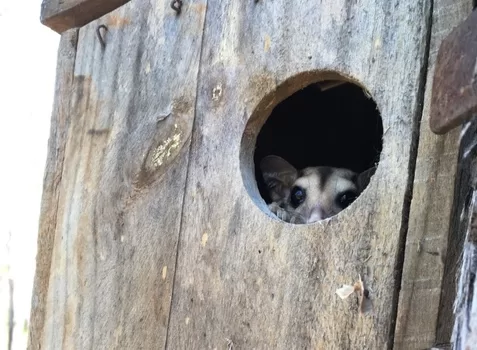A recent study has revealed a troubling decline in natural tree hollows is leading to a decrease in arboreal mammal populations in Northern Australia. Conducted by Charles Darwin University’s (CDU) Research Institute for the Environment and Livelihoods (RIEL), the study sought to determine whether the availability of tree hollows in Northern Australian tropical savanna is contributing to the decline of tree-dwelling mammals.
Over a three-year period, researchers surveyed 187 nestboxes installed across the Cobourg Peninsula within Garig Gunak Barlu National Park. They discovered that 67 percent of the nestboxes were used by mammals at least once.
Among the 119 nestboxes monitored by camera, 82 percent were used by mammals, with 56 percent occupied by the brush-tailed rabbit-rat, 44 percent by the savanna glider, 41 percent by the black-footed tree-rat, 15 percent by the fawn antechinus, and four percent by the northern brushtail possum.
Building Nesting Boxes for Natural Tree Hollows
Natural tree hollows are a critical component of many ecosystems, serving as homes for a diverse array of arboreal mammals such as possums, gliders, and bats.
Due to deforestation, land clearing, and bushfires, these vital habitats are rapidly diminishing.
To counteract this loss, building and installing nesting boxes is a practical and impactful solution that can help preserve these species and maintain ecological balance.
The Importance of Natural Tree Hollows
Tree hollows form in mature and old trees through natural processes such as decay, weathering, and the activity of wood-boring insects.
These cavities provide shelter and breeding sites for numerous species, offering protection from predators and harsh weather conditions.
For arboreal mammals, these hollows are essential for their survival, as they rely on them for raising their young and as resting places during the day.
Why Build Nesting Boxes?
Habitat Loss and Fragmentation
The primary reason for building nesting boxes is to mitigate the loss of natural tree hollows. Urban development, agricultural expansion, and logging have significantly reduced the number of mature trees, leading to habitat fragmentation. By installing nesting boxes, we can provide immediate and suitable alternatives for displaced animals.
Supporting Endangered Species
Several arboreal mammals, such as the Greater Glider and various species of possums, are facing the threat of extinction due to habitat loss. Nesting boxes can play a crucial role in the conservation of these endangered species by offering them a safe place to live and reproduce.
Enhancing Biodiversity
Nesting boxes contribute to biodiversity by supporting a variety of species. This, in turn, enhances the ecological health of the area, promoting a balanced and resilient ecosystem. The presence of arboreal mammals can also benefit other wildlife and plant species, creating a thriving natural environment.

How to Build and Install Nesting Boxes
Materials and Design
The first step in building a nesting box is to select durable, weather-resistant materials.
Marine plywood or untreated hardwood are excellent choices. It’s important to avoid using treated timber, as the chemicals can be harmful to wildlife.
The design of the nesting box should mimic the natural tree hollows as closely as possible.
Different species have different requirements, so it’s essential to research and understand the specific needs of the animals you intend to help.
For example, a box for a brushtail possum will differ in size and entrance hole diameter compared to one for a sugar glider.
Construction Tips
Ventilation and Drainage: Ensure the box has adequate ventilation and drainage holes to prevent overheating and water accumulation.
Safe Interior: The interior of the box should be rough to allow young animals to grip and climb easily. Adding a small piece of rough timber or a ladder can help.
Predator Protection: Incorporate features that protect against predators, such as a roof that overhangs the entrance or a narrow entrance hole.
Secure Fittings: Use screws instead of nails for construction to ensure the box is sturdy and can withstand weather conditions.
Installation
When installing nesting boxes, choose a location that closely resembles the animal’s natural habitat. Secure the box to a tree at an appropriate height, generally between 2-5 meters off the ground.
Ensure the box is firmly attached to prevent it from falling during strong winds or storms. Additionally, face the entrance away from prevailing winds and direct sunlight to keep the interior comfortable.
Monitoring and Maintenance
Regular monitoring and maintenance of nesting boxes are essential to ensure they remain safe and habitable.
Check the boxes periodically for signs of wear, damage, or infestation by pests such as ants or bees. Cleaning the boxes annually can help maintain a healthy environment for the inhabitants.
Building nesting boxes is a simple yet profoundly effective way to support arboreal mammals and contribute to biodiversity conservation.
By providing these artificial hollows, we can help mitigate the impacts of habitat loss, support endangered species, and promote ecological balance.
Whether you are a wildlife enthusiast, a conservationist, or simply someone who cares about the environment, constructing and installing nesting boxes is a rewarding and impactful way to make a difference.
The science of nesting boxes
Adjunct Research Associate Dr Leigh-Ann Woolley, the study’s lead author and RIEL Adjunct Research Associate, as well as the Northern Australia Biocultural Conservation Manager for WWF-Australia, expressed surprise at the findings.
“We were sceptical that mammals would use the nestboxes we deployed at all, never mind that their nestbox use would be strongly associated with tree hollow density at a site,” Dr. Woolley said.
“This showed that these declining arboreal mammals were searching for and using new dens where natural hollows were reduced at a local site.”
The study highlights that habitat quality should not be overlooked when addressing the multiple threats contributing to the decline of these species, such as inappropriate fire regimes, introduced ungulates, and feral predators.
Arboreal mammals are vital to savanna ecosystems, playing key roles in seed dispersal and plant pollination, and have adapted to the unique features of the savanna, including frequent fires and seasonal food sources.
To combat the decline and prevent extinctions of hollow-using animals in Northern Australia, Dr. Woolley emphasized the importance of protecting large savanna eucalypts.
“Good quality habitat with ample tree hollows for denning and nesting, as well as high quality and abundant food sources, will buffer against other serious threats to these animals,” she said.
She noted that higher tree density reduces the time these mammals spend on the ground, thus decreasing their vulnerability to predators like feral cats.
Short-term strategies to support arboreal mammals include halting land clearing and protecting large, hollow-bearing savanna eucalypts.
For long-term habitat optimization, Dr. Woolley suggested fire regimes dominated by cooler, less frequent fires to preserve large trees, increase tree hollow densities, and enhance food resources such as fruiting shrubs.
This collaborative study involved the Department of Biodiversity, Conservation and Attractions in Western Australia, the Department of Environment, Parks and Water Security in the Northern Territory, and the University of KwaZulu-Natal in South Africa.
The findings were published in the journal Forest Ecology and Management under the title “Nestbox use indicates declining arboreal mammals in an Australian savanna may be limited by tree hollow availability.”
Related stories
Our Gardening section
Nesting Boxes: Creative Upcycling for Wildlife Conservation
Growing Herbs in Containers on Apartment Balconies
Australia’s best tasting heirloom tomatoes
Global Food Production Dilemma: Grow & Buy Local
Farmers prepare for supercharged El Niño
Moss is vital for the health of soils – here’s why
Do you want to live on an Intentional Community



